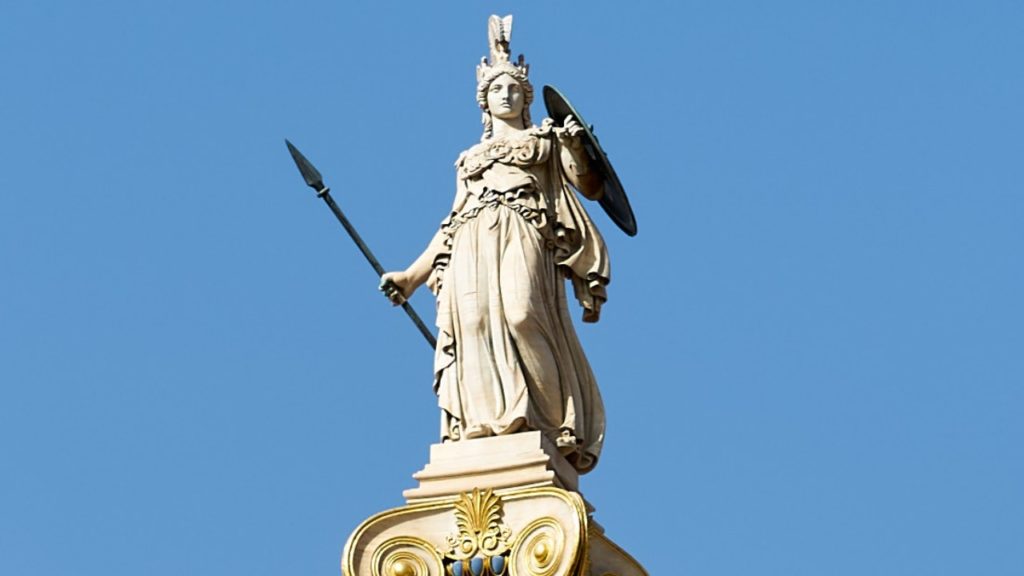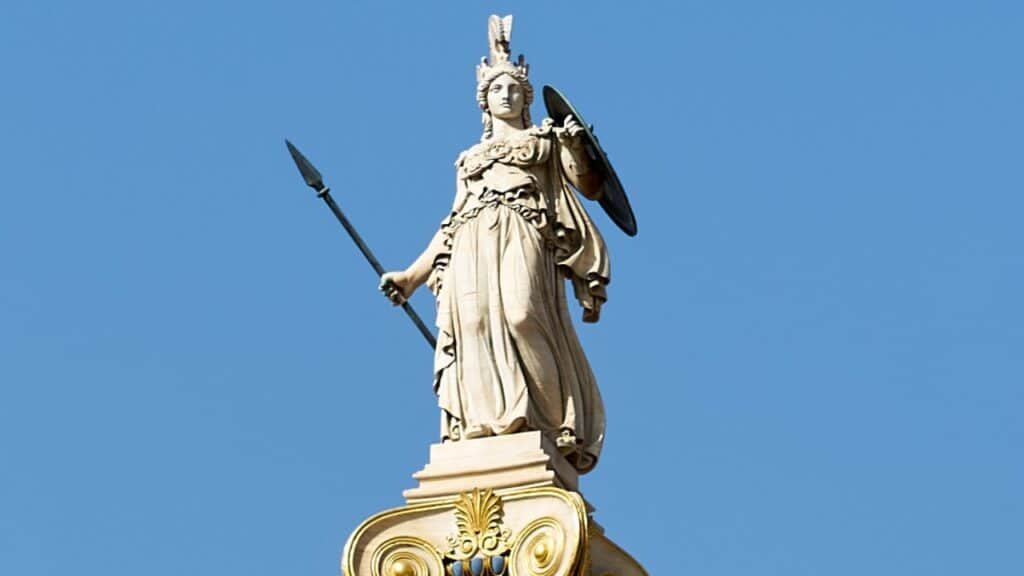
The cult of the ancient Greek goddess Athena gave some women of Athens liberties that extended past the roles of mother and homemaker. The life of Athenian women—like women in most towns throughout Ancient Greece—was largely restricted to the household.
It was only haiterai (courtesans) or women who were involved in religious activities that were able to move freely around town.
The ancient Greek goddess Athena: Her general influence
Athenian girls received little formal education, as it was considered unnecessary for them in the trajectory of their life. It was the cult of Athena, the protector of the city named after her, however, which positioned even young girls as active members of society. Those who remained unmarried continued as priestesses of Athena, while those who married were able to participate in religious festivals. They were respected as citizens and possessed a considerable amount of power as representatives of the ancient Greek goddess Athena.
The Olympian Athena was not only the goddess of wisdom but also the protector of cities, as she was renowned for her excellence in strategic warfare. She is commonly depicted in statues holding a spear. Athena was also the deity of weaving, pottery, and sculpture and embodied the core values of ancient Greek society. A masterful warrior, she was wise in practical affairs, courageous, and independent, remaining unmarried and symbolizing female virginity. Athena was among the most popular deities, and mortals throughout Greece dedicated shrines and temples to her, usually erected on a town’s acropolis.

The many epithets of the ancient Greek goddess Athena
The ancient Greeks had many epithets for the goddess due to her multiple attributes. She was Athena Polias (“of the city”), Athena Nike (“of victory”), Athena Ergane (“the industrious”), Athena Agerastos (“who never ages”), Athena Parthenos (“the virgin”), Athena Anymfeftos (“who is not married”), Athena Pallas (“who brandishes weapons”), Athena Promachos (“who fights on the front”), and Athena Aristovoulos (“who gives good advice”) among several other personas. According to Greek mythology, Athena sprang from the forehead of her father Zeus, king of the ancient Greek gods. She was Zeus’s favorite daughter.
In one myth that highlights her determination to remain a virgin, Athena goes to Hephaestus, the god of blacksmiths and metallurgy, to ask him to make some weapons for her. Mesmerized by her beauty, Hephaestus attempted to rape her, but she fought him off. During their struggle, a drop of his semen fell on her thigh, which she wiped away and flung onto the fertile earth. From that drop alone, Erechthonius sprang from the ground and later became king of Athens, while Athena remained a virgin. Erechthonius was considered the mythical founder of the Panathenaic Festival.
The most well-known colossal statue of her, the Athena Promachos, stood on the Acropolis of Athens between the Propylaea and the Erechtheion, as referred to by the ancient Greek traveler and geographer Pausanias (Description of Greece, 1.24.5–7, R. Waterfield, 95):
“The cult statue is made of ivory and gold. In the middle of its helmet is a sphinx and on either side of the helmet are carved griffins. The statue of Athena stands upright in an ankle-length robe, and on its breast is an ivory representation of the Gorgon Medusa. Athena holds in one of her hands a Victory [the goddess of victory, Nike], about four cubits tall, and in the other a spear. At her feet lies a shield and, by the spear, a snake which might be Erechthonius.”
The snake was said to have guarded Erechthonius when he was an infant enclosed in a casket. As a serpent-like entity, Erechthonius came to symbolize the protector of Athena’s temple on the Acropolis and, by extension, of Athens itself. The Erechtheion was named after him.
The ancient Greek goddess Athena: Patron of heroes

Athena was the protector of heroes in Greek mythology. She often intervened in their favor by encouraging and empowering them. Her name appears in most of the great, noble deeds of the heroes who stand out in the history of Ancient Greece. The goddess of wisdom and warfare often aided Heracles in completing his twelve heroic labors. She helped him hold the world for Atlas when he searched for the sacred apples of the Hesperides.
In Homer’s Iliad, she helped Achilles defeat Hector and saved Menelaus from the arrow of Pandarus. In the Odyssey, she advised Odysseus to dress as a beggar to enter the palace and then protected him from the arrows of Penelope’s suitors before he exterminated them all. When Perseus went on the quest to kill Medusa, Athena provided him with a shield to protect himself. It was the goddess of wisdom who advised Argo to build the first Greek long ship that Jason and his Argonauts would use on their mission to retrieve the Golden Fleece. In Aeschylus’ Eumenides, Athena appeased the Erinyes (Furies) to stop tormenting Orestes.
Discrimination faced by women of ancient Athens
There are records of lower-class Athenian women who worked as potters, craftspeople, and merchants and of upper-class women who worked as courtesans—but these were exceptions. Women who appeared outside the home were mostly female slaves, prostitutes, or metics (foreigners). Maidens, wives, and mothers typically stayed at home and remained under the control of a male guardian—either a father, husband, adult son, or another male relative.
Classicist Louise Bruit Zaidman comments on the women of Athens (Schmitt Pantel, et. al. 339-340):
“Athens, of course, was not all of Greece. As far as the place of women is concerned, the situation there was unusual, even extreme. Distrust of women, misogyny in rhetoric and law, were greater in Athens than anywhere else. Indeed, Athenian misogyny was so extreme that a myth was needed to explain why women there were not to be called Athenians and children were not to take their mother’s name. Varro tells us that it was to quell Poseidon’s ire, aroused when the women of Athens voted to name the city after Athena rather than himself. According to the Periclean law of citizenship (451 BC), citizenship was granted to any man who could prove he was the son of both a citizen and ‘the daughter of a citizen.’ When a boy was registered [at birth] the name of his mother’s father was recorded but not that of his mother. If the father swore that the son was the product of a marriage with a ‘woman of the city’ the mother’s name was not mentioned.”
The rulers of Athens restricted women’s role in society to childbearing, and it was generally believed that this alone was sufficient for a woman’s fulfillment. Marital sex was intended for procreation, while men sought sex for pleasure outside marriage—with younger men, male or female prostitutes, or hetairai. In ancient Greek theater, there were no female actors. Women’s roles were performed by men wearing masks with feminine features. Scholars continue to debate whether women were even permitted to attend the theater; if they did, it is believed they were seated separately from men.
The ancient Greek goddess Athena and women in the religious sphere
It was only in the religious sphere that women could participate equally in the life of the city and hold positions of respect and authority—primarily within the cult of Athena and in honor of other goddesses and gods. According to Zaidman, of the thirty religious festivals held annually in Athens, women participated in nearly half, as different celebrations reflected various aspects of women’s lives. In the annual Panathenaia in honor of Athena—celebrated with greater grandeur every four years—every woman, regardless of age or social status, was allowed to take part.
Young girls carried baskets of offerings to Athena during the Arrhephoria (carriers of sacred objects) and Plynteria (cleansing rites) festivals, both dedicated to Athena Polias. Married women participated in the Haloa, a women-only feast dedicated to Demeter and Dionysus for fertility and agricultural abundance, as well as in the Thesmophoria, another fertility and harvest festival in honor of Demeter. Women of canonical age—those who had reached puberty and were therefore considered eligible for marriage—served the queen of the Anthesteria, a festival presided over by Dionysus.
The raising of Athenian girls
From birth until the age of seven, upper-class Athenian girls and boys had more or less similar upbringings. After the age of seven, the father would take the boy by the hand, teach him his trade, and prepare him to become an Athenian citizen. Girls, on the other hand, were prepared for marriage, motherhood, and household management. Based on available records, this pattern most likely applied across all classes of Athenian citizens.
Between the ages of seven and eleven, the male assembly of Athens would select four upper-class girls, known as arrephoroi (“sacred basket bearers”), for a special and honorable duty. Two of them would help weave the large peplos (a body-length garment) that would clothe the statue of Athena in the Parthenon as an offering. The other two participated in a ritual in which they carried sealed caskets on their heads—caskets they were forbidden from looking into. They would place the caskets at a specific location in the gardens below the Acropolis and exchange them for other caskets, the contents of which were also unknown to them. These were then either carried up to the Acropolis or returned to their original source.
The ritual reenacted the story of Erechthonius, whom Athena placed in a small casket while he was still an infant to protect him and conceal his birth. She entrusted the casket to the three daughters of King Cecrops of Athens—Pandrosus, Herse, and Aglaurus—with strict instructions not to open it. Overcome by curiosity, Herse and Aglaurus disobeyed and looked inside.
They saw either the infant Erechthonius wrapped in the coils of a snake or a half-infant, half-serpent being. Horrified by the vision, they went mad and hurled themselves from the top of the Acropolis to their deaths. In the ritual reenactment, the young virgins chosen to carry the caskets symbolically atoned for the disobedience of Cecrops’ daughters by resisting the temptation to look inside and delivering the caskets unopened to their destination.
The noble kanephoroi and Athena
According to scholar Sarah B. Pomeroy, girls between the ages of eleven and fourteen from noble families were honored as kanephoroi. As virgins, the kanephoroi could carry sacred offerings and sacrificial instruments in their baskets. One ritual involved carrying a basket of sacred barley to be placed on the altar for animal blood sacrifices. Since women in Athens were not allowed to participate in blood sacrifices themselves, the position of the kanephoros serving the goddess Athena was highly coveted among the city’s maidens. Those who were not chosen often tried to tarnish the reputation of the selected kanephoroi out of envy.
The most famous example of how serious the rejection of a candidate could be occurred in 514 BC, when the sister of Harmodius was refused selection as a kanephoros. At the time, Athens was ruled by the sons of Peisistratus, Hippias (ruled circa 528–510 BC) and Hipparchus (ruled circa 528–514 BC). Hipparchus had propositioned a young man named Harmodius, who rejected him. In retaliation, Hipparchus dismissed Harmodius’ sister from the role of kanephoros without explanation—a move perceived as questioning her virtue and insulting the family’s honor.
In response, Harmodius and his lover Aristogeiton assassinated Hipparchus during the Panathenaic Festival of 514 BC. This event led Hippias to become more tyrannical, and ultimately, in 510 BC, to his fall and the restoration and development of Athenian democracy. The kanephoroi could continue to serve Athena through their early teens until marriage. Women could also be chosen as hiereiai, or high priestesses, based on family connections or recognized virtue. Their service could last until marriage, for only one year, or for the entirety of their lifetime. The most prestigious position for an Athenian woman was that of high priestess of Athena. She was considered the conduit of the goddess’s will to the people.
Herodotus (Histories 8.41) recounts that when the Persians invaded Greece in 480 BC, the high priestess of Athens ordered the people to evacuate the city for safety just before the Battle of Salamis. She told them that the serpent Erechthonius—and thus Athena—had already fled the Acropolis, and they should do the same. The Athenians heeded her warning, evacuating women and children before returning to defend the city. Beyond the cult of Athena, women honored with religious roles also participated freely alongside men in the rites of Demeter, the Eleusinian Mysteries, and other festivals. Even after marriage and motherhood, these women continued to contribute to Athena’s cult and were respected and honored by society.


